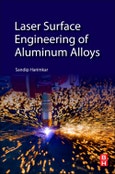Laser Surface Engineering of Aluminum Alloys presents a comprehensive overview of LSE approaches (laser surface melting, laser alloying, laser cladding, laser composite surfacing, laser shock peening) for all of the Al alloy systems, including the developing 8xxx series alloys. The book discusses in detail the influence of laser processing parameters on the development of microstructure, mechanical/electrochemical properties, residual stresses and defects. Laser surface engineering (LSE) of Al alloys is of considerable scientific and technological interest due to unique processing features such as rapid cooling rate, non-contact heating and superior process control.
Aluminum (Al) alloys are the one of the most popular structural materials due to their ductility and high strength-to-weight ratio, and have been extensively used in aircraft, automobile and sports industries. However, these alloys often exhibit insufficient corrosion resistance, stress-corrosion cracking resistance, and wear resistance properties for applications in these industries. Significant efforts are now directed toward modifying the surface characteristics of these alloys for improved surface properties.
- Provides a comprehensive overview of laser surface processing approaches, including thermal aspects, compositional effects and microstructure development associated with each approach
- Features separate chapters/sections for all Al alloy systems, including newer emerging systems
- Provides a valuable reference for further research in the area
- Covers the techniques used for surface preparation of aluminum alloys for laser processing, including details such as focus parameters, nozzle designs, inert gas and safety relevant to operation of practical laser surface processing set-ups
Table of Contents
1. Introduction 2. Laser surface engineering of aluminum: Processing practices and major concerns 3. Laser surface melting of aluminum alloys 4. Laser surface alloying of aluminum alloys 5. Laser shock peening of aluminum alloys 6. Case studies and future directions








